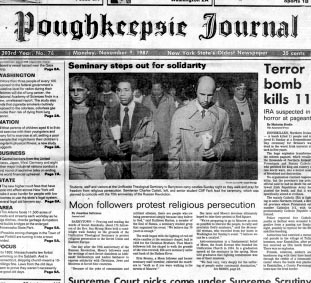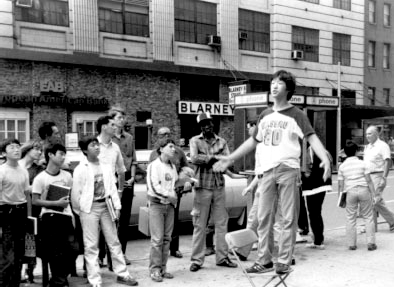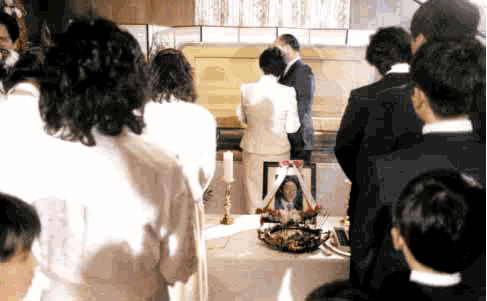
40 Years in America

|
|
40 Years in America |
|
Spiritual Revival

During the 1970s and early 1980s, Rev. Moon concentrated his activities almost exclusively in the United States, conducting evangelical tours between 1972-76 and building an institutional base between 1977-85. After 1985, he shifted the focus of his ministry, conducting concurrent marches on Moscow and Korea between 1985-92 that this chapter has documented. While he elevated his ministry to the international level, the real focus between 1985-92 was on Korea. Rev. Moon hoped to harvest the fruits of his worldwide ministry there and to play a central role in the nationís reunification. This was apparent in the succession of the movementís annual mottos after 1986: "The Unification of the Fatherland" in 1987 and 1988; "The Unification of Korea" in 1989; and "The Unification of My Nation" in 1990 and 1991. There was a sense that Korea as the holy land of Unification faith was always the internal focus of Rev. Moonís ministry. The difference was that between 1985-92, it became the substantial focus as well.
From the perspective of the American movement, this shift was not a negative development as it built upon the foundation of Rev. Moonís foundation in America, and activities in Korea as well as in the C.I.S. required the assistance of American members and their contacts. Still, the situation had changed. The most fundamental change was that after being at the center of Rev. Moonís attention for nearly a decade and a half, the U.S. movement was less in a central than a supportive role. The movement continued to fund The Washington Times and its oceanic enterprises as well as a broad array of educational and inter-religious nonprofits in the U.S. However, rather than breaking new ground, this support served to maintain and extend activities already in place. The only dramatic new initiative in the U.S. during the period was the Professors World Peace Academyís acquisition of a controlling interest on the Board of Trustees of the University of Bridgeport, Connecticut in 1992. This was a hotly contested and highly controversial situation that resurfaced anti-Unification Church sentiment and recalled the "cult wars" of the 1970s. Nevertheless, apart from the University of Bridgeport involvement, which occurred at the end of the period and had more relevance for later developments, the cutting edge of the movementís efforts between 1985-92 was not in the U.S.
The membership in America plunged into CAUSA signature drives and recruitment for ICC minister tours as they had with previous providential tasks. However, there was an undeniable void. This was not simply due to the numerous and lengthy absences of Rev. and Mrs. Moon. It was more due to the fact that their interest lay elsewhere. In reality, this shift of focus offered the American movement and its membership possibilities for growth, especially a deepening of its spiritual roots. The wider culture, for the most part, still held them in contempt, and the movementís Asian leadership, including Rev. Moon, told them on numerous occasions that they were horizontal and individualistic, lacking in dedication, and spiritually dry. In addition, members continued to struggle with the conflicting demands of family and mission responsibilities. Some struggled with additional issues such as infertility or infidelity, matters that struck at the heart of their faith. In summary, at the grassroots level, the American movement was primed for a spiritual revival.
It would be a mistake to assert that these issues were unique to American members. The membership worldwide tended to regard their efforts as inadequate. While the True Parents turned some of their failures into victories, most felt that they had increased rather than lessened the True Familyís burden. Some self-abasement was rhetorical. In other words, it was considered good form to depreciate oneís own efforts and attribute all success to heaven, the True Parents, or oneís superiors. Also, no segment of the movement was exempt from Rev. Moonís scolding. If American members labored under unflattering comparisons to Asians, Rev. Moon reversed field when addressing Korean audiences, comparing their settled state with the suffering and sacrificial efforts of American witnessing and fundraising members. And his criticism of the U.S. and American members paled in comparison to his treatment of the Japanese.
Again, some of this was rhetorical. However, other aspects of the movementís sense of inadequacy or even failure were rooted in fact. The world was still an unfriendly place for most Unificationists after 1985, and despite certain gains, no country or culture held members in high esteem or considered them part of their mainstream. Beyond this, there was disunity among members themselves, which raised the question of whether the movement truly offered the promise of transformation or, in fact, mirrored the worldís divisions. Korean, Japanese and American members had problems understanding and trusting each other. European members perpetuated centuries-old conflicts, and native African members distrusted their missionaries. The movementís interracial, international and intercultural marriage blessings were a witness to the ideal of unification. Yet, in some cases, blessed marriages were religious, racial and cross-cultural battlegrounds. The high regard that members had for Rev. and Mrs. Moon held the movement and many marriages together externally. Internally, members often felt impoverished. In this respect, not only the American membership but the worldwide Unification movement of the mid-1980s was ripe for revival.
A revival did come. It was not a conventional revival, and in the end it raised a number of troubling questions. Nevertheless, it had a profound effect on many members. Rev. Moon and numerous participants described it as a "Unification Pentecost." In outline, it centered around extraordinary experiences that an increasing number of members had with Heung Jin Moon, Rev. Moonís deceased second son. Shortly after his death on January 2, 1984 as a result of a car accident, a number of spiritually sensitive members in a variety of locations throughout the world claimed to have received messages and direct guidance from him. These appearances were particularly intense during the forty days following Heung Jin Nimís Sung Hwa or "ascension" ceremony, after which they subsided for three years. A second phase, associated with the ICC minister conferences, began in 1987 and led to widespread channeling of Heung Jin throughout the movement. This phase quickly escalated into a third, culminating phase in late 1987 and 1988 when Heung Jin Nim was understood to be embodied twenty-four hours a day in a young Black Zimbabwean member who led a series of revival meetings attended by thousands of church members worldwide.
There were several reasons why this revival took hold. The first factor, already described in general terms, related to the membershipís receptivity, indeed, hunger for revival. The editor of Todayís World, the churchís world mission magazine, summarized the situation,
The last few years...have truly been painful for me in that it has been increasingly difficulty to find the fresh enthusiasm and purity of heart that I felt was a precious, core aspect of our movement. Those who join the Unification Church have to be among the most fundamentally idealistic people on earth. Yet the perspective of many brothers and sisters had become tinged with cynicism, revealing the hurt, disappointment, and resentment that had accumulated from Satanís attack on our ideals.
Our original mindís expectations for ourselves and each other -- leaders and members -- had been too often betrayed. I and many others were praying desperately for some sort of rebirth or revival, but we had no idea from where it would come.
Prior to "having experiences with Heung Jin," David Hose, a major ICC leader, wrote, "I had reached a point of real dryness...feeling that my love channel was cut off, that I was just going through the motions in my work." He also generalized beyond his situation to that of others: "I could give lectures to thousands of people on the Principle and explain how much God loves each and every one of us, but I could not really accept in my heart that God loves...[me]. As I look around our American movement, I find that there are a lot of people in the same position."
The Heung Jin Nim phenomena addressed these areas of need and more, empowering members in their public missions and personal lives. In Britain, a forty-day witnessing condition under the guidance and in the spirit of Heung Jin Nim between January 21 and February 29, 1984 gained 733 new members. Although many of them signed associate rather than full-time membership forms, the British Church surpassed its original goal of 200, and its revised figure of 500. ICC staff also attributed breakthroughs with Christian ministers to the influence of Heung Jin Nim. At the churchís World Mission Headquarters in Manhattan, a small prayer group exploded from five or six people to 150 within a few days once several participants began channeling Heung Jin Nim. At the churchís seminary in Barrytown, New York, a small prayer group likewise expanded to the whole community, and a student-sponsored "Soul of Russia" prayer walk grew from 20 walkers in the previous year to more than 200 with front-page coverage in local media. This, as well, was attributed to Heung Jin Nimís direct involvement.
Received messages affirmed that Heung Jin Nim wanted to be close to each and every member, that he was "their brother, not only some distant Lord," that God had not forgotten their sacrifices, and that they were "beautiful children -- each one handpicked." In the face of contempt from without the movement and scolding or layers of hierarchy within, affirmations of this sort were deeply stirring. Heung Jin Nim also held forth the promise of overcoming barriers and disunity among members. As one account put it, he came "as a great equalizer and redresser. No single nationality is superior or inferior." Position, organization, self-consciousness and image were out. Heartistic unity was in.
A second reason why the revival took hold related to the character of Heung Jin Nim and the circumstances of his death. By all accounts, Heung Jin Nim, who was seventeen when he died, was an exemplary son. Rev. Moon described him as "the most exemplary, obedient son, with the greatest piety...the most comforting son to Mother and me." He was known to be particularly concerned about safeguarding the security of his parents. The circumstances of his death were tragic. Having visited the church seminary in Barrytown, New York with two friends, their car was struck by a tractor-trailer that had jack-knifed on an icy stretch of road north of Poughkeepsie on December 22, 1983. Though seriously injured, his two friends survived. Heung Jin Nim, who suffered massive head injuries, lingered in a coma for ten days before expiring at 1:18 a.m. on January 2, 1984. Given Heung Jin Nimís exemplary character and the circumstance of a young life, so full of promise, being snuffed out, there was intense pressure to find meaning in the tragic turn of events. This happened in several ways. First, the boys who had been traveling with Heung Jin Nim testified that he had swerved the car at the last moment to take the brunt of the impact himself and save them. This may have been in keeping with Heung Jin Nimís character or elevated it further and in that way may have offered some consolation. However, it did not address the issue of why the tragedy happened at all or, more precisely, why God let it happen.

In his early teens, Heung Jin Nim took part in a second-generation workshop, during which they street preached in New York City.
On January 3, 1984 Rev. Moon referred to Heung Jin Nimís death as a great sacrifice. He and Mrs. Moon were out of the country at the time of the accident, conducting a series of "victory over communism" rallies in Korea. A number of church and non-church spiritualists communicated to Mrs. Moon that December 1983 was a "very dangerous time" for Rev. Moon and that he "must absolutely be careful." Rev. Moon asserted that at the last rally in Kwangju, a city with a reputation for rebelliousness, thirty-six terrorists were prepared to attack but were prevented from doing so because "the auditorium was already completely packed by the time they arrived." With another 5,000 people outside, they "had absolutely no way to enter." However, during Rev. Moonís speech, Heung Jin Nimís accident occurred. According to Rev. Moon, "Satan lost his condition to attack me and then turned his attention to the next best, my second son."

The family attend Heung Jin Nimís Seung Hwa at Belvedere.
As one who had laid down his life for his friends and stood as a substitute for his father, Heung Jin Nim "occupied the position of the living Jesus in the Unification Church." This meant that his sacrifice had a larger atoning significance. While he lay in a coma, Rev. and Mrs. Moon conducted a Unification Ceremony in the hospital chapel where on the foundation of Heung Jin Nimís "precious sacrifice," they called for the unity of Judaism, Christianity and the Unification Church; the unity of Korea, Japan and the United States; the unification of True Parents and their family and for the members of the Unification Church as well as all races of the world. After his passing, on January 3, 1984, Rev. and Mrs. Moon established the Day of the Victory of Love. Rev. Moon explained,
Previously, the realm of death controlled the realm of love... From now on, love will control the realm of death... This is truly a historical day. The death of the most beloved son of True Parents might be tragic for Mother and me if death reigned in our hearts. However, we are not defeated by death. Instead, we are reaching out with the much greater power of the love of God, and love now governs death...All tragic events of the satanic world shall be conquered by love and enter into its realm. No power under the sun can infiltrate the power of love. Heung Jin Nimís death is not an ordinary one; he transformed himself into the victory of love. His death cannot be treated as an ordinary secular death.
The Day of the Victory of Love found a permanent liturgical expression in the churchís tradition of Seung Hwa ("ascension and harmony") ceremonies, which began after Heung Jin Nimís death. Unlike traditional funerals, these ceremonies were not to be gloomy or sad but "beautiful, enlightening and joyful," using bright or light colors. However, Heung Jin Nimís victory transcended the church. To Rev. Moon, Heung Jin Nim was "opening the door to conquer death" and his spirit was "totally free to come back here any time he wants to." A variety of spiritual communicators also said, "He will be back. He will come back." These sentiments were highly suggestive and enhanced membersí receptivity to testimonies of Heung Jin Nimís appearances.
A final reason why the Heung Jin Nim revival took hold stemmed from the movementís openness to the spirit world. Unlike its aggressive evangelism, anticommunism, business ventures, or even its messianism, this aspect of the movementís life was not emphasized in the public media. The movement itself was ambivalent about spiritualism. There was a degree of reticence; even sensitivity about associations with shamanism and excessive preoccupation with the spirit world was discouraged. Nevertheless, those possessing charismatic and spiritual gifts played prominent roles within the tradition from its beginnings. Rev. Moon was the outstanding example. He reportedly was clairvoyant, clairaudient and could see into peopleís characters from childhood. Jesus appeared to him at age fifteen, and "For many decades," according to Divine Principle, "he wandered in a vast spiritual world...endured suffering unimagined by anyone in human history...fought alone against myriads of Satanic forces...[and] came into contact with many saints in Paradise." Many of the earliest members of the movement were spiritualists or spirit-led, and contingents of "prayer ladies" and mediums provided ongoing communication with the spirit world.
Much of this was inaccessible to ordinary members. It was part of the churchís tradition, and most were aware that Rev. Moon had spoken on numerous occasions of barriers being broken in the spiritual world. Still, for many, this was a matter of long ago and far away. In this respect, the Heung Jin Nim phenomena and revival represented the mainstreaming of the movementís spiritualist tradition.
Download entire page and pages related to it in ZIP format
Table of Contents
Information
Tparents Home